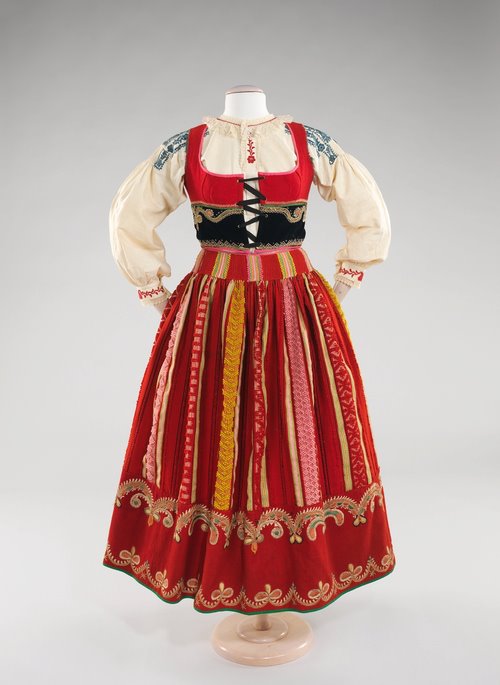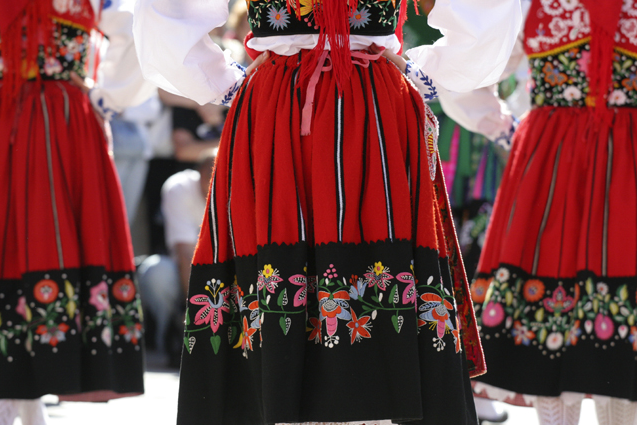Hello all,
Today I will be entering another new country, Portugal.
This is the most famous costume of Portugal, and the most colorful. You will often see it representing Portugal as a whole. It is native to a number of villages around the city of Viana do Castelo in the the northern Province of Minho [pronounced meenyo]. This city lies on the Atlantic just north of the mouth of the river Limia.
This area has several costumes which differ according to purpose and to social class. The costume I will be speaking of is called 'Traje de Lavradeira' by the local people. In the rest of Portugal it is often called the costume of Viana do Castelo, and outside Portugal it is usually referred to as the Minho costume.
There are minor differences between the various villages, and also, as you can see by the first photo, the costume comes in two color variations: vermelho [red], and azul or verde [blue or green]. The second is also known as traje de do' which can be loosely translated as the sad costume.
The red version is considered to be the 'happy' version, and is worn by younger women. The blue or green versions are worn in times of semi-mourning or other sadness, such as the absence of a loved one, and by older women.
The base layer is a linen chemise, camisa, with blue floral satin-stitch embroidery on the front, the shoulders, upper sleeves and cuffs. There is a band of smocking at the top of the sleeve as well. Here is an old chemise showing the cut.
Today, the chemise is usually made in two pieces, forming a blouse and a narrow underskirt. A full petticoat is worn on top of the first.

There is a separate bodice, colete, which is always sewn in two parts. The upper part is of the major color of the outfit, red, blue, or green, and the lower part is black. The seam between the two is said to follow the line of the diaphram, and therefore promotes healthy breathing. The front is cut rather low, and there is usually an ornament in the shape of a heart.
There is usually a line of embroidery, trim or braid along the seam, and varying amounts of embroidery on the bodice. An amazing variety exists, from quite simple to very colorful and busy.
You will also see examples with debased embroidery, which can be churned out quickly and are intended for the tourist market.
The skirt, saia, is made of heavy wool or linen. If of wool, it has a background color of either red or blue/green, with narrow stripes of other colors widely spaced. You can see in this photo above that there is a narrow band gathered into the waistband, and then the body of the skirt is gathered into this band. This is how the skirt can be made so full. There is a wide band sewn onto the hem. This is usually black, but in some villages on the seashore it may be red. It may be left plain or it may have embroidery which matches the black part of the bodice.
Here we see several women wearing the Lavradeira costume, and two wearing the Mordoma costume which is also from the same region.
The hem is usually around ankle length, but like in so many places, some dance groups have decided to shorten it.
There is a simpler version of this costume called domingar which is for Sundays and going-to-market. The full costume is for festivals. This has a skirt of plain or striped linen. The top part of the bodice may be made of linen as well.
The older geometric designs are now mostly worn with the domingar version of the costume. Personally I find them much more attractive than the garish pink roses.
A separate pocket, algibeira, is worn with this costume. It is embroidered and is in the form of a stylized heart. While this is decorative it has a practical purpose in carrying keys, wallets, handkerchiefs, etc. This is a common souvenir which people often bring back from Portugal.
A kerchief is worn on the head. If there was any older headdress it has been forgotten. A similar scarf is worn on the shoulders for the Lavradeira costume, but not the Domingar. They come in various colors, but mostly have the same design.
Backless slippers with a low heel, chinelas, are worn, or like many peasants all over Europe they often go barefoot. These may be plain or embroidered. Knit stockings are worn with the chinelas. There also exist stockings without feet, which may be worn when barefoot or with the slippers, to keep the legs warm, i assume.

Of course, the full lavradeira costume is not complete without an abundance of gold jewelry.
The men's costume is straightforward. Black pants, red sash, black jacket.
The only unique detail is the linen shirt which is embroidered, usually in blue or red cross-stitch.
Sometimes a shirt for special occasions will be embroidered in white on white.
The Domingar costume for the Atlantic coast villages is white, and includes the fisherman's cap which is widespread in the mediterranean.
One interesting fact is that the wedding costume in this area, as in some other places around Europe, is black.
I will close with some more images of this costume.
This seems to be a website where you can buy pieces of this costume. At least there are some good closeups.
http://www.casamartaaraujo.pt/TrajesdeViana/trajesdevianafemininos/trajesdevianafemininos.html
Here is a slideshow of the costumes of this region.
http://www.youtube.com/watch?v=Osf9s0ppzyQ
Here is a dance group from the town of Viano do Castelo. The dancers are all wearing the domingar costume, but the lavradeira and mordoma costumes are worn by those who are singing.
http://www.youtube.com/watch?v=GgIK3bvAAe8
Here is a village folkloric group from this region doing a performance at a festival. It opens with some backstage chatter, but it does show a lot of dancing, including the famous Vira; and shows off both the domingar and lavradeira costumes. This is a longer clip.
http://www.youtube.com/watch?NR=1&feature=endscreen&v=ZjKh6zuH9bo
Feel free to contact me with requests for research. I hope to eventually cover all of Europe and the Former Russian Empire/Soviet Union. I also gratefully accept tips on source materials which i may not have. I also accept commissions to research/design, sew, and/or embroider costumes or other items for groups or individuals. I also choreograph and teach folk dance.
Roman K.
Rkozakand@aol.com
Source material:
I would like to thank Marcos León Fernández for providing me with information and some of these photographs.
I obtained some good information from this website:
http://trajesdeportugal.blogspot.com.es/2006/08/trajes-do-minho.html
Claudio Basto, 'Traje a Vianesa', Gaia - Portugal, 1930
Tomaz Ribas, 'O Trajo Regional em Portugal', Braga, Portugal, 2004
R. Turner Wilcox, 'Folk and Festival Costumes of the World', New York, 1965
Robert Lee Humphrey, Jr., 'Spain and Portugal', Broomal, PA, 2003




































1000P.jpg)


























